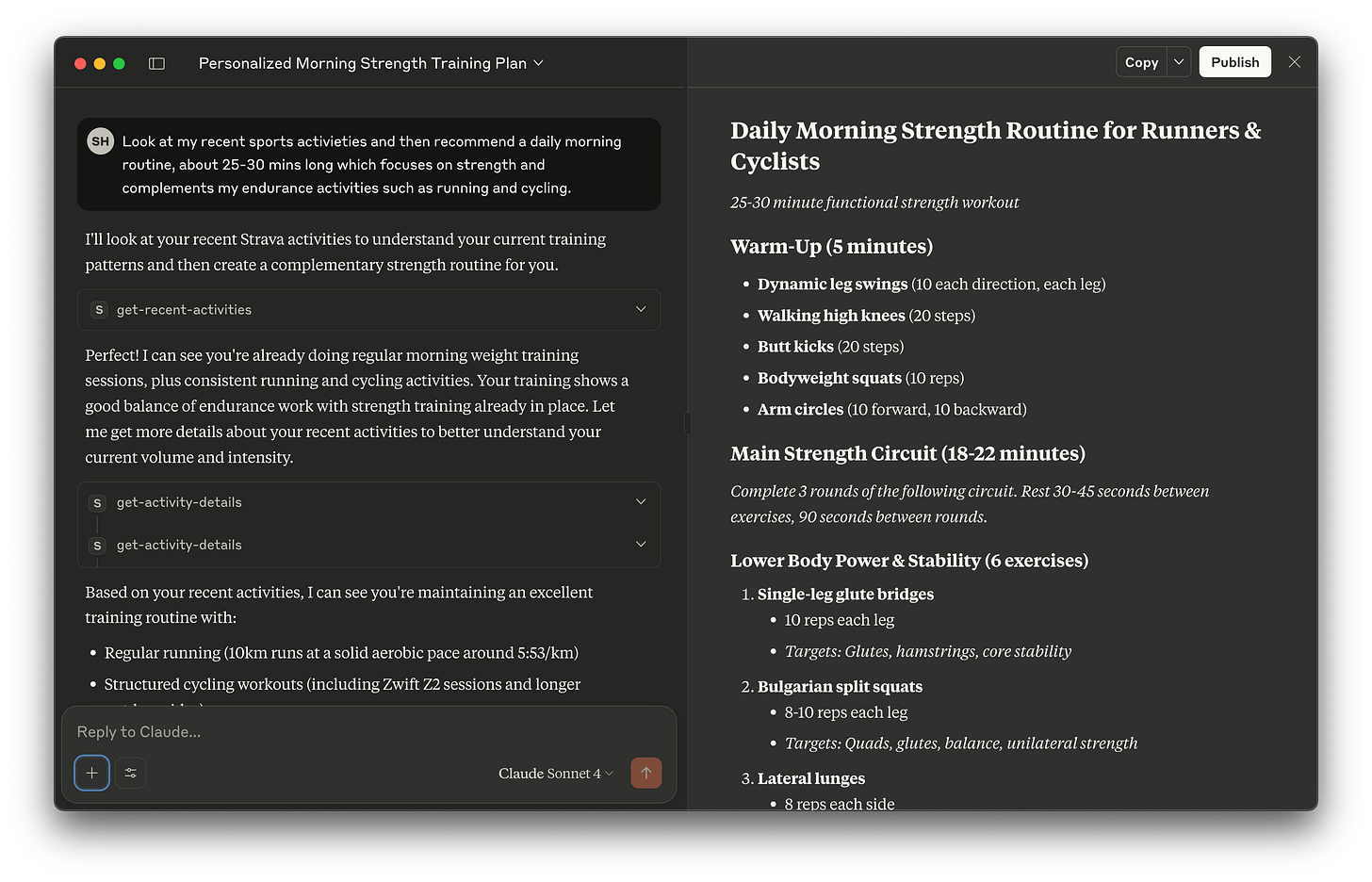Unlocking Your Strava Data: An Agentic AI Approach
How I Use AI to Analyze My Training Data
Unlocking Your Strava Data: An Agentic AI Approach
The world of AI is moving fast, and you've probably heard about Agentic AI and the Model Context Protocol (MCP). Think of MCP as a standardized way for an AI agent—like the one in Claude Desktop—to connect with different services and use their "tools."
I've been using this to supercharge my training analysis by connecting Claude to my Strava data. This allows the AI agent to access recent activities, profile info, and even analyze my performance over a specific period. It's a game-changer for getting personalized insights.
While there are many Strava MCP servers out there, I've had great results with this one. Of course, feel free to explore others and let me know what you find!
Getting set up is straightforward:
Clone the project from GitHub. (Always a good idea to check the code yourself.)
Add a
.envfile with your Strava API application details.Add the server to Claude Desktop under the Developers tab in Settings, following the instructions in the GitHub README.
Once you're connected, the possibilities are endless. I primarily use this setup to create tailored training plans that fit my specific needs. Here are a couple of prompts I've used:
“Look at my recent sports activities and then recommend a daily morning routine, about 25-30 mins long which focuses on strength and complements my endurance activities such as running and cycling.”
Or, for an even more focused plan:
“Look at my recent sports activities and then recommend a daily morning routine, about 25-30 mins long which focuses on strength and complements my endurance activities such as running and cycling. From 10th of August to 20th of August I will be on vacation in France and won't be able to cycle, so focus the training on complementing the running during this time.”
The AI generates a detailed output, which I print out and use as a monthly guide. It's a simple and effective way to get a customized training plan.
Sample below…
How do you use tech to improve your training or daily routine? Share your thoughts in the comments!
Daily Morning Strength Routine for Runners & Cyclists
25-30 minute functional strength workout
Warm-Up (5 minutes)
Dynamic leg swings (10 each direction, each leg)
Walking high knees (20 steps)
Butt kicks (20 steps)
Bodyweight squats (10 reps)
Arm circles (10 forward, 10 backward)
Main Strength Circuit (18-22 minutes)
Complete 3 rounds of the following circuit. Rest 30-45 seconds between exercises, 90 seconds between rounds.
Lower Body Power & Stability (6 exercises)
Single-leg glute bridges
10 reps each leg
Targets: Glutes, hamstrings, core stability
Bulgarian split squats
8-10 reps each leg
Targets: Quads, glutes, balance, unilateral strength
Lateral lunges
8 reps each side
Targets: Hip stability, adductors, injury prevention
Single-leg calf raises
12 reps each leg
Targets: Calf strength, ankle stability
Wall sit to squat jumps
30-second wall sit + 5 explosive squat jumps
Targets: Endurance strength + power
Single-leg deadlifts (bodyweight)
8 reps each leg
Targets: Posterior chain, balance, running mechanics
Core & Upper Body Support (4 exercises)
Plank variations
30-45 seconds (alternate: standard, side planks, plank with leg lifts)
Targets: Core stability, postural strength
Bird dog
8 reps each side (hold 3 seconds)
Targets: Core stability, hip stability, coordination
Push-ups (modify as needed)
8-12 reps
Targets: Upper body strength, core stability
Dead bug
8 reps each side
Targets: Deep core stability, coordination
Cool-Down & Mobility (2-3 minutes)
Standing forward fold (30 seconds)
Figure-4 hip stretch (30 seconds each side)
Standing calf stretch (30 seconds each side)
Gentle spinal twists (30 seconds)
Key Benefits for Your Training
For Running:
Injury Prevention: Single-leg exercises improve balance and address imbalances
Power Development: Plyometric elements enhance running economy
Core Stability: Better posture and efficiency during long runs
Hip Strength: Reduces risk of IT band and knee issues
For Cycling:
Pedaling Power: Unilateral leg strength improves power transfer
Core Endurance: Better position maintenance during long rides
Hip Flexibility: Counters cycling's hip flexor tightness
Upper Body Support: Reduces fatigue in aero positions
Progression Tips
Week 1-2: Focus on form, use bodyweight only
Week 3-4: Add small weights/resistance bands if available
Week 5+: Increase reps, add more challenging variations
Scheduling Recommendations
Easy Training Days: Full routine (30 minutes)
Hard Training Days: Focus on mobility + light core (15 minutes)
Rest Days: Full routine with emphasis on mobility
This routine complements your existing endurance training and current weight sessions perfectly!



